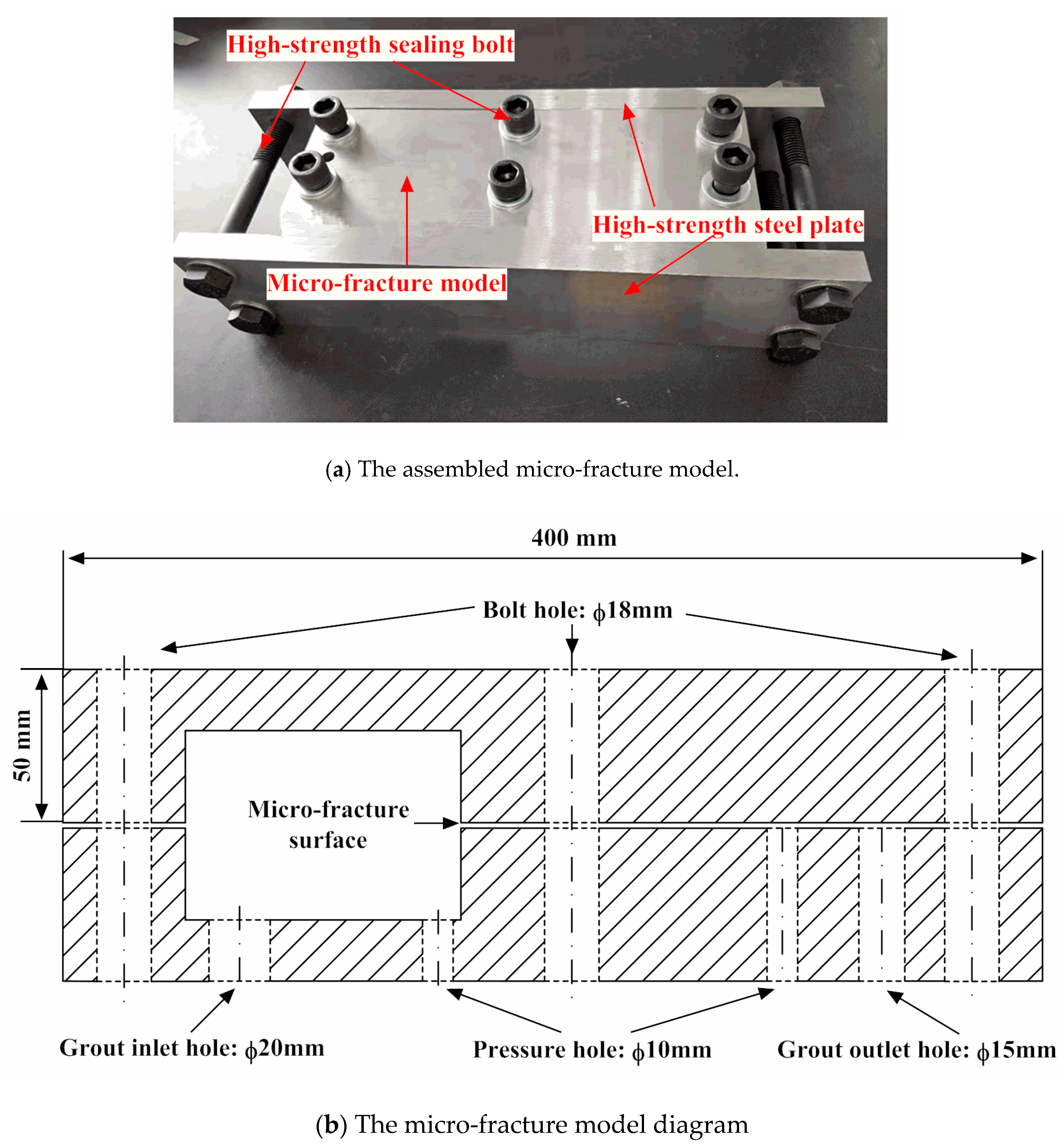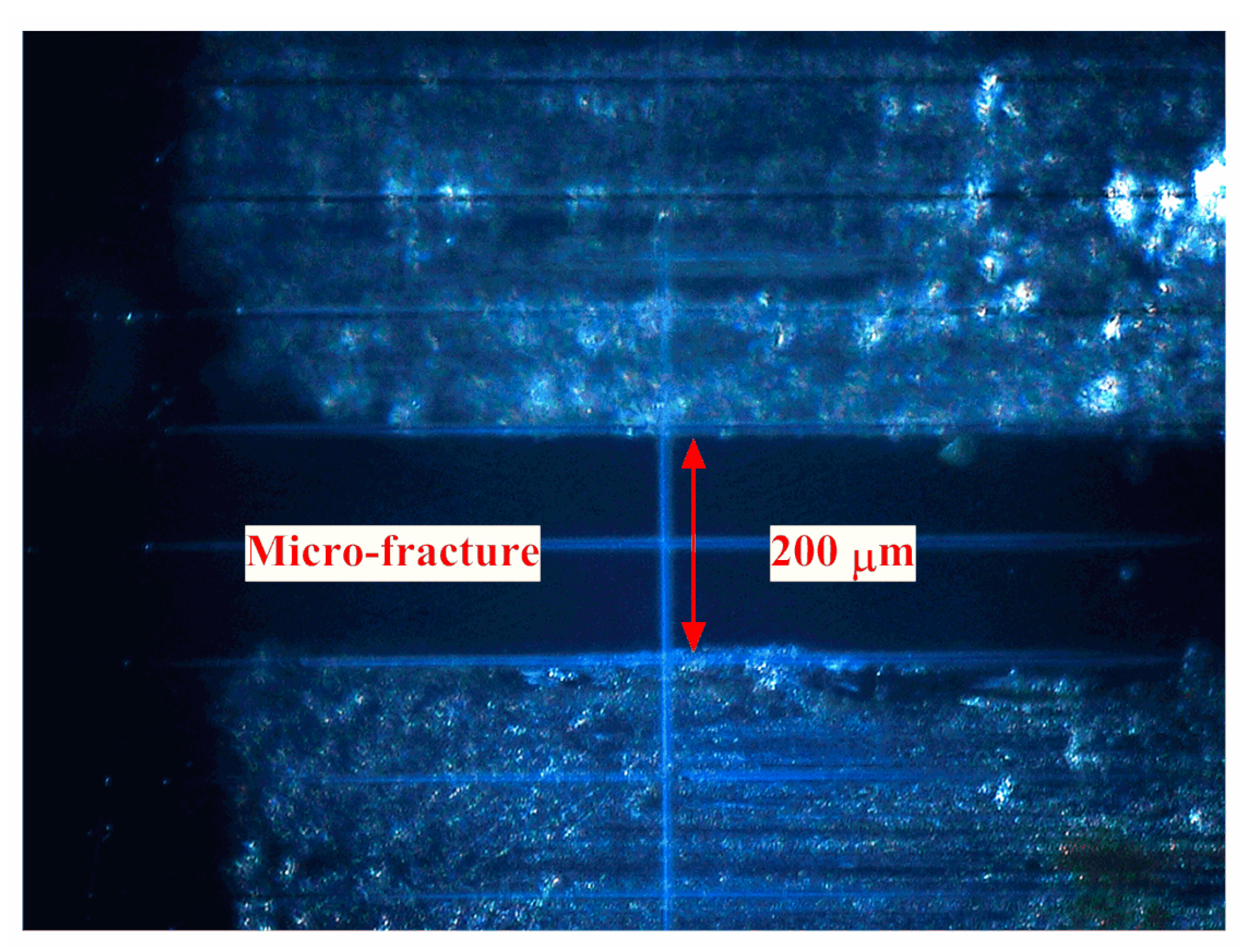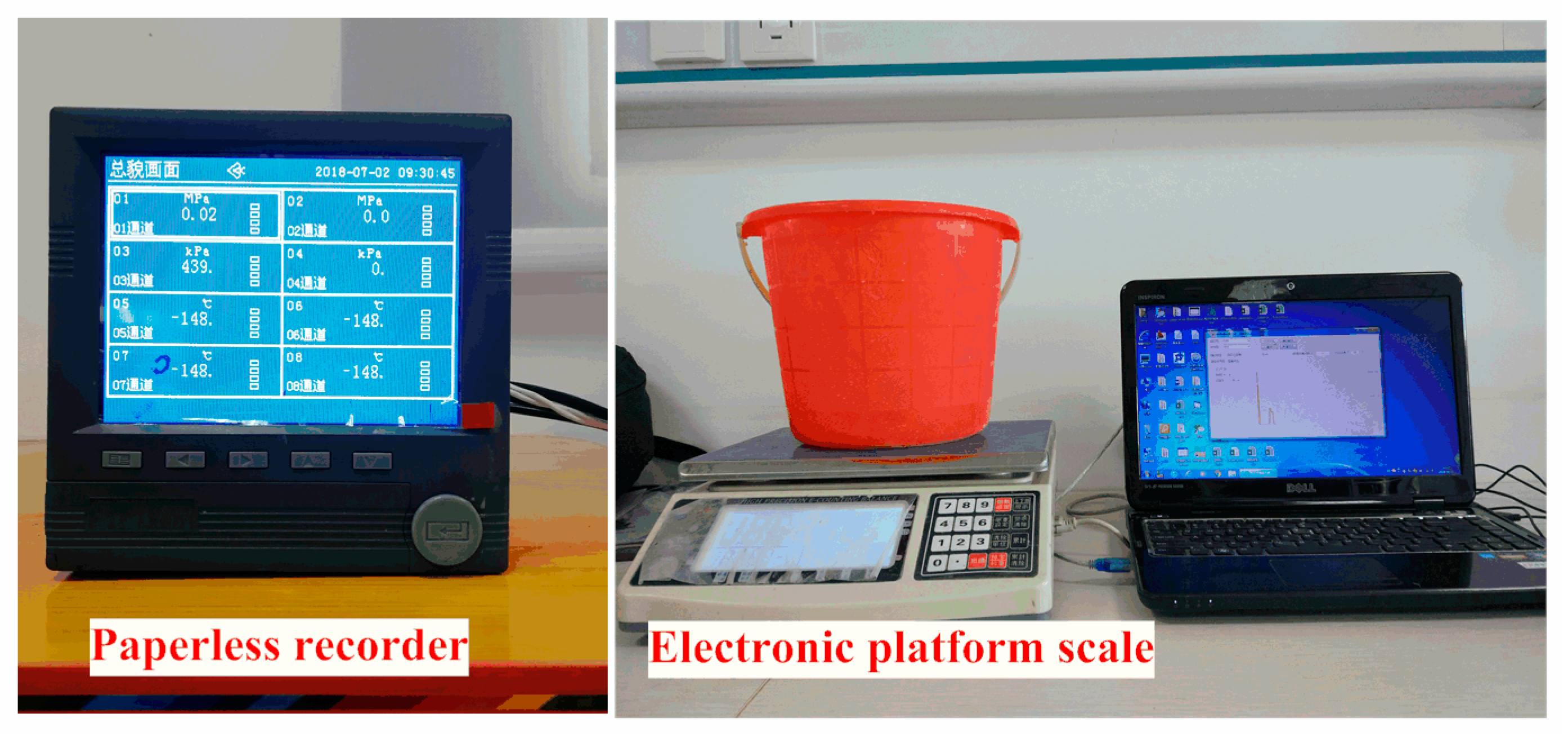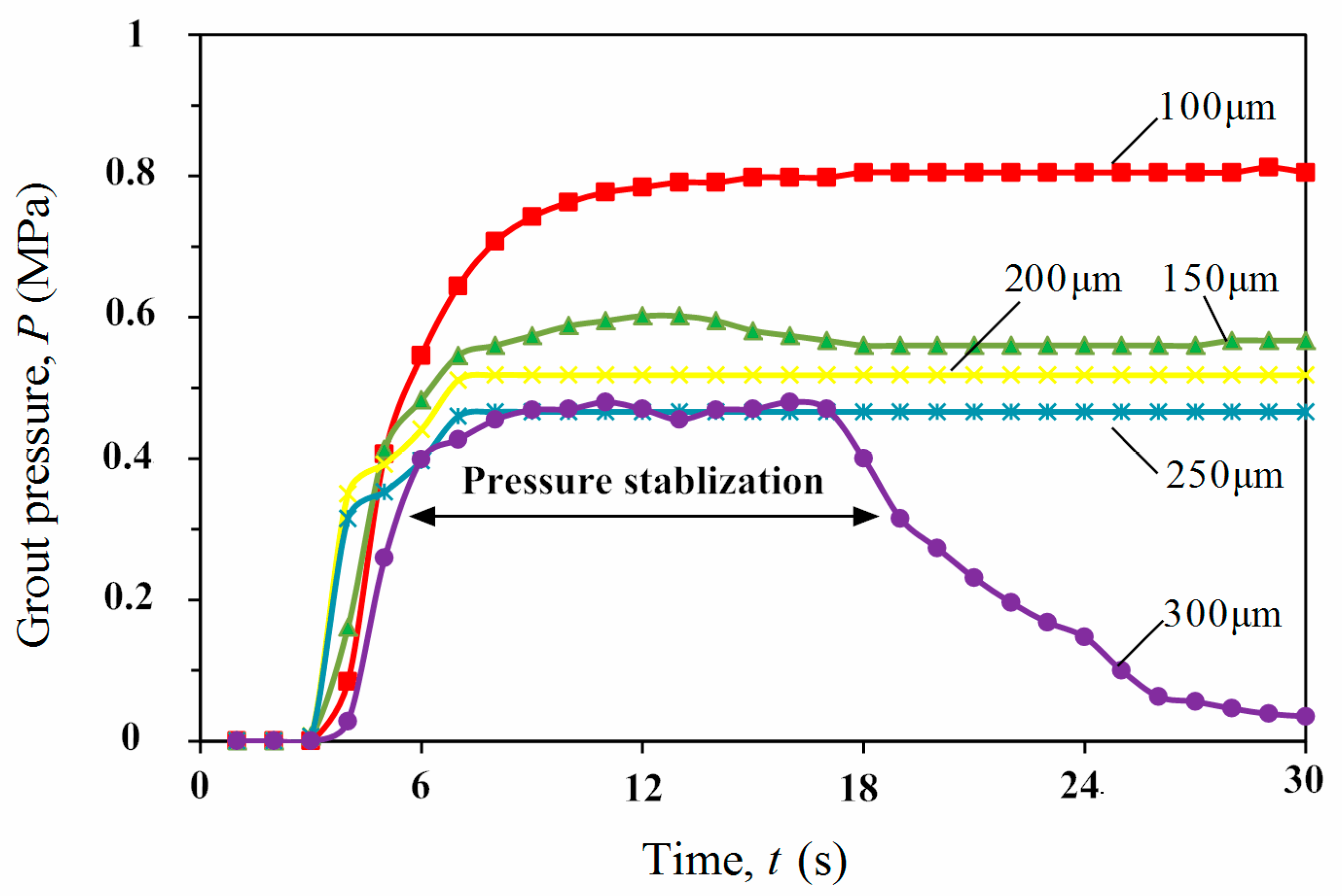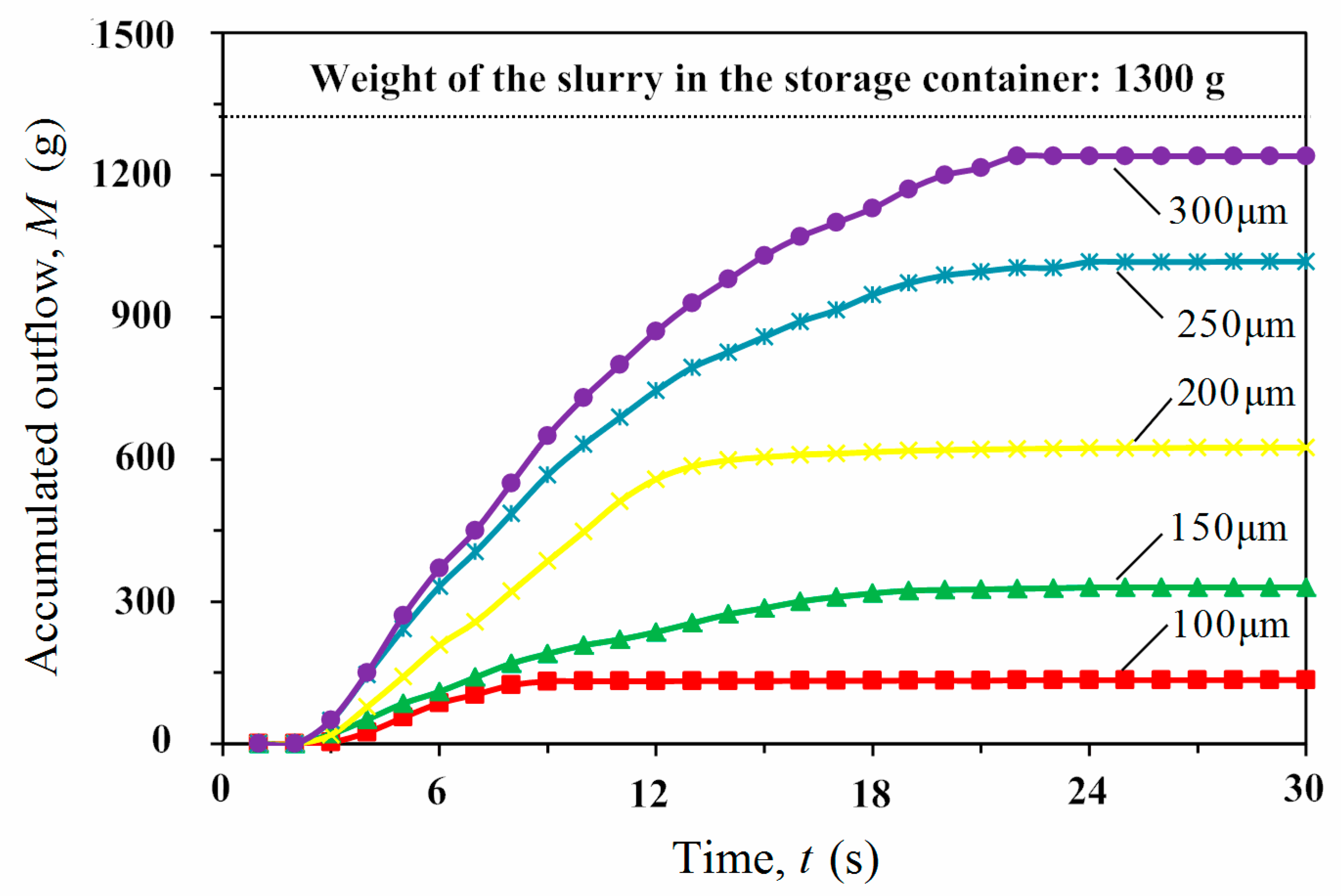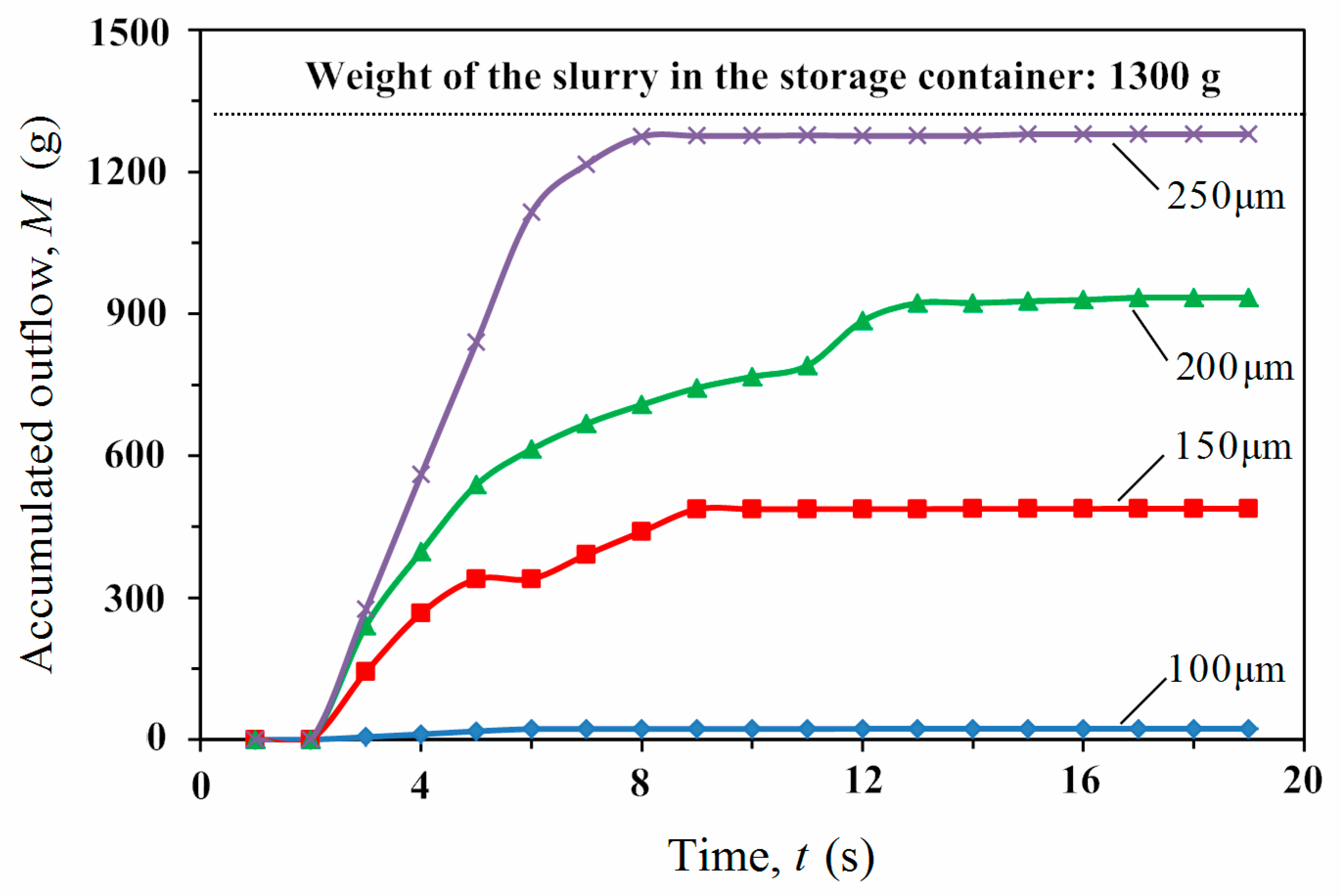4.1. Test Results of Low-Pressure Grouting
Figure 5 and
Figure 6 show the permeability test results of UPC45 at different fracture openings when w/c = 1.2.
Figure 5 presents the grouting-pressure change curve at different fracture openings at the entrance of the fracture during the grouting process.
Figure 6 presents the curve of the cumulative flow rate of the outlet at different fracture openings during the grouting process.
There are two types of grouting pressure curves shown in
Figure 5. One occurs when the fracture opening is 150 μm, 200 μm, and 250 μm; here, the grouting pressure rapidly increases after the grouting starts and maintains a relatively stable position until the grouting ends. The other occurs when the fracture opening is 300 μm; the grouting pressure decreases after the rapid pressure increase and pressure stabilization phase and gradually decreases to 0 by the end of the grouting process. Combined with
Figure 6, it can be seen that when the fracture opening is 150 μm, the cumulative weight curve at the outlet is quickly stabilized after a brief increase. The cumulative weight is only 75.2 g, accounting for 5.7% of the total weight (1300 g) in the slurry storage container, which is far less than the total weight of the slurry. When the fracture opening is 200 μm and 250 μm, the cumulative weight at the outlet is greatly improved when the fracture opening is 150 μm—437.5 g and 904.3 g, respectively, accounting for 33.6% and 69.5% of the total weight of the slurry in the storage container. Compared to the total weight, the weight of the passed slurry is still less. When the fracture opening is 300 μm, the cumulative weight at the outlet increases to 1149.1 g, accounting for 88.3% of the total weight of the slurry in the storage container, which is slightly lower than the total weight. At this time, the cumulative weight is very close to the total weight of the slurry in the storage container, but some slurry still cannot enter the fissure due to the percolation phenomenon. When the fracture opening is small, the percolation effect occurs immediately after the grout enters the fracture inlet, and the grout forms a filter cake at the fracture inlet, leading to grouting channel blockage and grouting pressure stabilization. With an increase in the fracture opening, the time needed for the slurry to form a filter cake at the fracture entrance is delayed, but the filter cake will still be formed and block the fracture entrance. When the fracture opening increases to a critical fracture opening, no seepage effect will occur. When the slurry completely passes through the fracture, the grouting pressure will decrease rapidly.
To quantitatively evaluate the permeability of cement slurry in a fracture, two critical fracture opening values of bmin and bcrit are usually defined: bmin represents the minimum fracture opening that the grout can penetrate at all, and bcrit represents the minimum fracture opening that the grout can penetrate without filtration. We further define the slurry passing rate as the ratio of the outlet cumulative weight to the total weight of the slurry in the storage container. Since the slurry will remain in the grouting pipeline during the test, when the pass rate is less than 5%, the grout cannot penetrate into the fracture at all. Moreover, since that part of the slurry will remain in the storage container during the test, when the pass rate is greater than 90%, the grout can penetrate into the fracture without filtration. In addition, the K value is defined as the ratio of the fracture opening to the particle size d95, and the K values of the two critical fracture opening degrees are Kmin = bmin/d95 and Kcrit = bcrit/d95, respectively.
According to the above test results, when the fracture opening is 150 μm, the slurry pass rate is 5.7%. Here, the fracture opening is the minimum fracture opening that the grout can penetrate at all, bmin = 150 μm. When the fracture opening is 300 μm, the slurry passing rate is 88.3%, so the slurry passing rate has not yet reached 90%. At this time, the fracture opening is still not the smallest fracture opening value that the grout can penetrate without filtration. Therefore, we assume that the slurry can completely enter the fracture without the occurrence of percolation (bcrit = 325 μm). The d95 of UPC45 is about 45 μm, and the K values of the two corresponding critical fracture openings are Kmin = 3.3 and Kcrit = 7.2.
Next, we continue the permeability tests of UPC24, UPC15, and UPC13 under different fracture openings when w/c = 1.2. UPC45, UPC24, UPC15, and UPC13 have similar characteristics in their grouting pressure curves and cumulative weight curves at different fracture openings. Due to the differences in the particle sizes of the cement particles, the fracture openings that different cement slurries can pass through are also different. The test results for the example of UFC13 are shown in
Figure 7 and
Figure 8.
The grouting pressure curve experienced a pressure increase and pressure stabilization when the fracture openings were 100 μm, 150 μm, 200 μm, and 250 μm. Similarly, only at a fracture opening of 300 μm did the pressure curve experience three stages: pressure increase, pressure stability, and pressure decrease. According to the cumulative weight change curve, when the fracture opening is 100 μm, the cumulative weight is 72.4 g, which accounts for 5.56% of the total weight of the slurry in the storage container. When the fracture openings are 150 μm, 200 μm, and 250 μm, the cumulative weights are 329.9 g, 625.1 g, and 1017.4 g, respectively, accounting for 25.3%, 48.1%, and 78.2%. When the fracture opening is 300 μm, the cumulative weight increases to 1240 g, accounting for 95.3% of the total weight of the slurry in the storage container. The grouting pressure curve of UFC13 is similar to that of UFC45. However, with a decrease in the particle size, the fracture opening that the cement particle can be injected into decreases correspondingly. However, because the UFC ultrafine cement particle size is too small, the agglomeration between the particles is obvious, so the critical fracture opening of the slurry without the infiltration effect is still large.
According to the above test results, when the fracture opening is 100 μm, the slurry pass rate is 5.56%. The fracture opening at this time is the minimum fracture opening that the grout can penetrate at all (bmin = 100 μm). When the fracture opening is 300 μm, the slurry pass rate is 95.3%, so the minimum fracture opening that the grout can penetrate without filtration is 300 μm—that is, bcrit = 300 μm. The d95 of UFC13 is about 13 μm, and the K of the two corresponding critical fracture openings are Kmin = 7.7 and Kcrit = 23.1, respectively.
4.2. Test Results of High-Pressure Grouting
Compared to the low-pressure grouting test, the pressure change curve and the cumulative weight change curve under high-pressure grouting have similar characteristics.
Figure 9 and
Figure 10 show the permeability test results of UPC45 under different fracture openings when w/c = 1.2.
When the fracture openings are 100 μm, 150 μm, and 200 μm, the grouting pressure curve experienced a pressure increase and pressure stabilization phase. Only at a fracture opening of 250 μm did the pressure curve experience three phases: pressure increase, pressure stability, and pressure decrease. The difference here from low-pressure grouting is that when the fracture openings are 150 μm and 200 μm, the grouting pressure curve shows obvious fluctuations. As shown in
Figure 10, when the fracture opening is 100 μm, the cumulative weight is only 22.9 g, accounting for 1.75% of the total weight of the slurry in the storage container, which is much lower than the total weight. When the fracture openings are 100 μm and 200 μm, the cumulative weights are 488.2 g and 934.4 g, respectively, accounting for 37.5% and 71.8% of the total weight of the slurry in the storage container. When the fracture opening is 250 μm, the cumulative weight increases to 1279.6 g, accounting for 98.4% of the total weight of the slurry in the storage container, which is slightly less than the total weight. Under high-pressure grouting, the grouting pressure curve shows an obvious fluctuation phenomenon, which occurs because the cement slurry is blocked at the entrance and exit of the fracture. However, under the action of high grouting pressure, the blockage at the entrance and exit of the fracture is washed away, and the fracture passage must be re-formed before the grouting can continue. However, a blockage quickly formed at the entrance to the fissure will end grouting. When the slurry can pass through the fracture completely, the grouting time is much lower than that of low-pressure grouting.
According to the above results, when the fracture opening is 100 μm, the slurry passing rate is only 1.75%, and when the fracture opening is 150 μm, the slurry passing rate is only 37.5%. The minimum fracture opening that the grout can penetrate at all is between 100 μm and 150 μm (bmin = 125 μm). When the fracture opening is 200 μm, the slurry pass rate is 71.8%, and when the fracture opening is 250 μm, the slurry pass rate is 98.4%. The minimum fracture opening that the grout can penetrate without filtration is between 200 μm and 250 μm (bcrit = 225 μm). The d95 of UPC45 is about 45 μm, and the K values of the two corresponding critical fracture openings are Kmin = 2.2 and Kcrit = 5, respectively.
Next, we continue the permeability tests of UPC24, UPC15, and UPC13 at different fracture openings when w/c = 1.2. The test results for the example of UFC13 are shown in
Figure 11 and
Figure 12.
The grouting pressure curve experiences a grouting pressure increase and pressure stabilization phase when the fracture openings are 50 μm and 100 μm. Only with a fracture opening of 150 μm does the pressure curve experience three phases: pressure increase, pressure stability, and pressure decrease. When the fracture opening is 100 μm, the pressure curve experiences fluctuations, similar to the former. As shown in
Figure 12, when the fracture opening is 50 μm, the cumulative weight is only 72.6 g, which accounts for 5.6% of the total weight of the slurry in the storage. When the fracture opening is 100 μm, the cumulative weight is 989.8 g, accounting for 76.1% of the total weight of the slurry in the storage. When the fracture opening is 150 μm, the cumulative weight increases to 1292 g, accounting for 99.4% of the total weight of the slurry in the storage. Although UFC13 experiences the particle agglomeration phenomenon, under high-pressure grouting, a higher grouting pressure will promote the advance of the granules, reduce the occurrence of the filtration effect, and improve the injectability of the fracture. Here, grouting pressure instead of the fracture opening is the key factor.
According to the above test results, when the fracture opening is 50 μm, the slurry passing rate is 5.6%. The fracture opening at this time is the minimum fracture opening that the grout can penetrate at all (bmin = 50 μm). When the fracture opening is 100 μm, the slurry pass rate is 76.1%, and when the fracture opening is 150 μm, the slurry pass rate is 99.4%. The minimum fracture opening that the grout can penetrate without filtration is between 100 μm and 150 μm (bcrit = 125 μm). The d95 of UFC13 is about 13 μm, and the K values of the corresponding two critical fracture openings are Kmin = 3.8 and Kcrit = 9.6, respectively.
4.3. Discussion of the Test Results
The critical opening and permeability trends of UFC with different particle sizes from the low-pressure grouting test are shown in
Table 2. As the particle size of the UFC continues to decrease, the minimum injectable fracture opening of the UFC changes to a value of 100 μm after decreasing continuously. When the particle size is reduced from UFC15 to UFC13, the b
min value is still 100 μm. This shows that reducing the particle size of cement is helpful for injection into micro-fractures, as cement particles with a small particle size are more likely to enter the fracture. However, by only reducing the cement particle size, the effect on reducing the minimum injectable fracture opening is limited. As the particle size of UFC continues to decrease, the trend of the b
crit value is to first decrease and then increase. When the particle size of UFC is 15 μm, the b
crit value is 275 μm. When the particle size of the UFC continues to decrease to 13 μm, the b
crit value becomes 300 μm, and the fracture opening increases. This mainly occurs because when the particle size of UFC decreases to a certain degree, its specific surface area is large, and the phenomenon of agglomeration between ultrafine cement particles is serious.
The critical opening and permeability trends of UFC from the high-pressure grouting test with different particle sizes are shown in
Table 3. As the particle size of UFC continues to decrease, the b
min value decreases from 125 μm for UFC45 to 50 μm for UFC13. The overall trend shows a decrease, indicating that reducing the particle size of cement is helpful for injection into a micro-fracture, as cement particles of a small size are more likely to enter the fracture. As the particle size of UFC continues to decrease, the change trend of the b
crit value of UFC is the same as the b
min value, and both continue to decrease.
Compared to the low-pressure grouting, the critical fracture opening for high-pressure grouting is reduced to varying degrees. Under low-pressure grouting conditions, bmin is reduced from 150 μm at UFC45 to 100 μm at UFC15. At this time, reducing the sizes of the cement particles has little effect on grout injection, so the bmin of UFC13 is still 100 μm. Under the condition of high-pressure grouting, as the UFC particles continue to decrease, the bmin decreases from 125 μm at UFC45 to 50 μm at UFC13, and the overall change trend shows a decrease. When the fracture opening remains unchanged, the effect of increasing the grouting pressure alone on increasing the groutability of the cement slurry becomes smaller. Under the condition of low-pressure grouting, as the particle size of UFC continues to decrease, the change trend of bcrit is to decrease first and then increase; bcrit decreased from 325 μm at UFC45 to 275 μm at UFC15. When the particle size continued to decrease to UFC13, bcrit increased to 300 μm. This occurred mainly because the smaller the particle size of the cement is, the larger its specific surface area, and the more serious the agglomeration phenomenon between the cement particles will be. Under high-pressure grouting conditions, bcrit continued to decrease. Comparing bcrit under high- and low-pressure grouting conditions under the same particle size, increasing the grouting pressure significantly reduced bcrit to a maximum of 175 μm, indicating that it is more difficult for cement particles to occur at the entrance of the fracture under high grouting pressure. Under low-pressure grouting, the particle size dominates the percolation effect; in the case of high-pressure grouting, the grouting pressure instead of the particle size dominates the percolation effect.
The floor elevation of the third-level main roadway in Haizi Coal Mine is −1000 m. Under the action of high in situ stress, the fractures in the surrounding rock are mostly compressed and closed. The traditional grouting support is adopted in roadway support, but the grouting effect cannot meet the design requirements, which leads to serious roadway deformation and threatens the safety of coal mine production. According to the test results in this article, the reasons for the poor effect of the original grouting support are the improper grouting materials and low grouting pressure, which leads to the failure of the grout particles to enter the micro-fractures. Therefore, the grouting design scheme was improved to change the grouting material from ordinary Portland cement to UFC15 with the best injectability and fluidity, and the grouting pressure was increased from the original 2 MPa to 5 MPa. The improved support scheme can ensure that the grout can pass the micro-fracture with the opening less than 150 μm, thus ensuring the grouting effect and controlling the deformation of surrounding rock.

